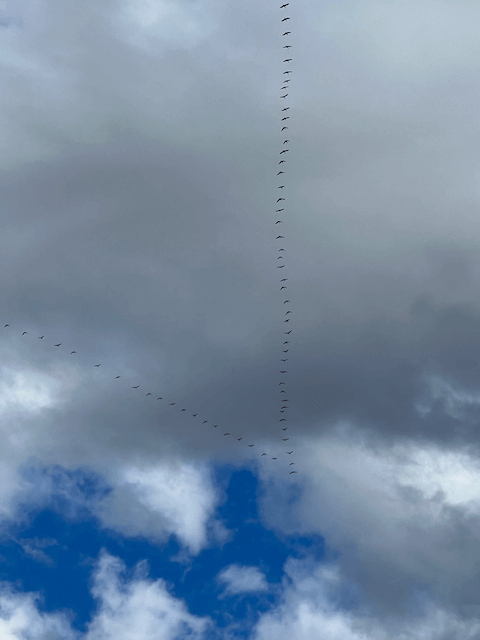
Last night, as the sun set, I heard the familiar songs and trills of migrating sandhill cranes in the distance. Their overhead passing is a week early, as they are usually spotted in droves passing through in mid-October. Though their familiar calls as they sweep the sky in formation are always a welcome sound.
Their flight pattern often takes them directly over my home. Our house sits close to the soaring buttes of the Pine Ridge National Forest, where thermals sweep the birds high into the overhead clouds for their flight south. Those following these first flocks will continue to keep the sky filled with their music. I love to listen to their wings sweep the air in unison. It sounds like a large glider soaring through the sky.
Then I remember. The cranes begin their flight because the season is changing. Cold is on its way. It is October. Snow will be here in no time. Walking my canyon, I noticed how the leaves had turned sharply from green to gold in the past few days. Our nights have cooled off, reaching into the low 40’s. I don’t think I’m ready yet to be done with Autumn. But it is a short season, as is our Spring. Winter is the longest; it often arrives as early as September with frost warnings and even the white stuff.
Last night, the birds flew because they already knew we would have low temperatures. It was 35 degrees when I awoke this morning. When I stepped outdoors early with my dogs, they told me with their humped shoulders and tucked tails that they weren’t ready for the change either. They both looked at me to say, “When did this cold show up?”
They are older now, two large hunting dogs who prefer sleeping indoors under the warmth of their blankets. I pulled my robe close around my neck. A chill ran down my spine.
I waited on the east porch for the dogs and listened to the wild turkeys foraging on the hay bales nearby. More than 50 had already assembled. Their clutches begin to gather for winter protection. Soon, there will be more than 100 in our trees.
To the east, the sky was already a brilliant orange as the sun burst over the edge of tomorrow. I watched the turkeys fluff their feathers as the sunlight’s warmth lit the bales. Some of the males even fanned their tail feathers. Shaking them, they show off to the hens. A loud gobble rises out of the mix, wings flap, and sparring begins between the youthful male jakes. The older females chase the fighting cocks back, and with wings spread wide, the gals sweep the ground toward the bantering boys. Only months old, young poults scurry aside into the dry wild sunflowers, hiding from the skirmish.
Suddenly, the roughhousing atop the bales silences, the ten-pound birds crane their neck high and look around. Something nearby has caught their attention. In unison, they take flight into the nearby cottonwoods and hackberry trees. It’s an eagle. It, too, is waking and looking for breakfast. Its silhouette, high above the hay bales, silently sweeps past, continuing its flight north.
My gaze follows the eagle’s flight path.
To the far distant north, the gray and white gliders approach high, their long legs follow behind rudder-like. Their melodic trilling intensifies, rising in crescendo as they close rank overhead. The cranes are passing through.
They know.
Snow is on its way.
Share this post: on Facebook on Google+ on LinkedIn
